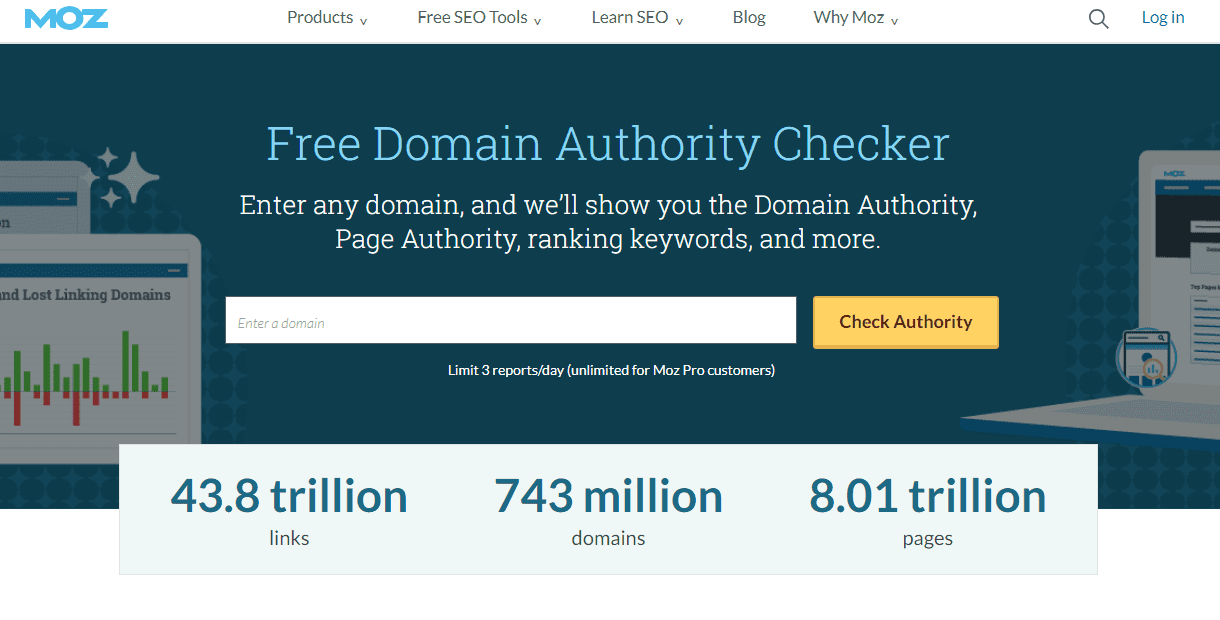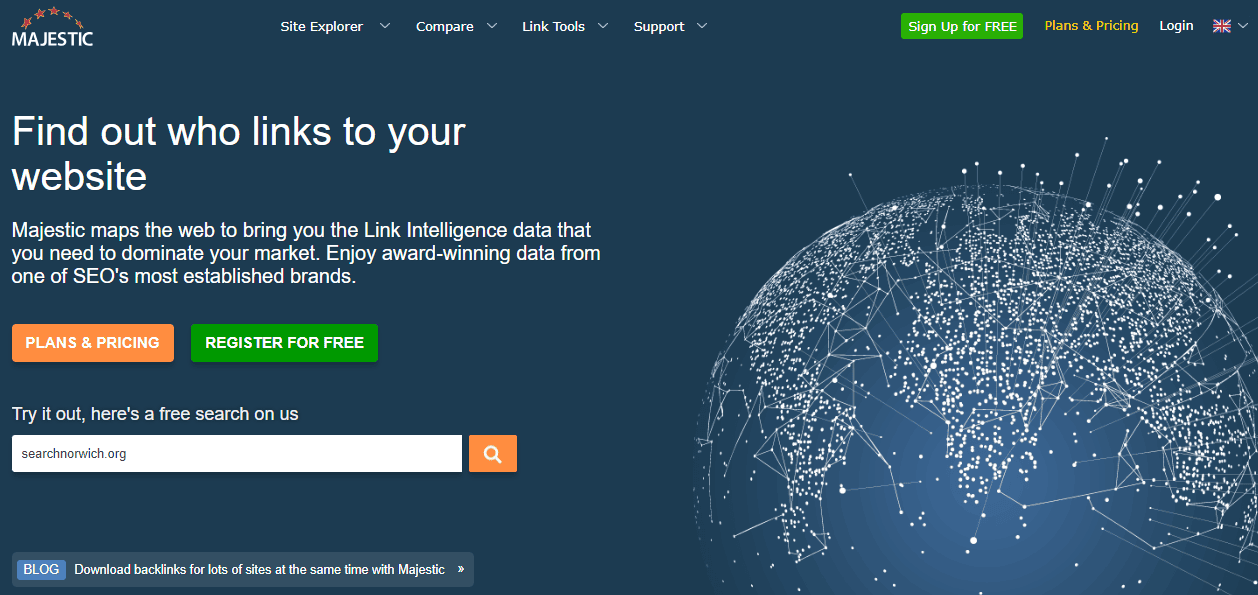- SEO
SEO Agency
Take advantage of the first traffic acquisition lever by entrusting your SEO to a digital agency experienced in SEO. - SEA
SEA Agency
Grow your business quickly with paid search (SEA).
- Social Ads
Social ads
Optimize your social media advertising campaigns to improve your performance.TikTok adsGo viral with your ads on TikTok
- Agency
The agency
Keyweo was born from the desire to create an agency that meets the principles of transparency, trust, experience and performance. - Blog
- Contact
Domain Name Authority
Home > SEO Agency > SEO Glossary > Domain Name Authority
Definition
Domain Authority (DA) is a metric used to assess the credibility of a website in the eyes of Google. Domain Authority is often expressed as a score between 0 and 100. It’s just an indicator, and having a high Domain Authority score is not synonymous with good search results.
The authority score was originally invented by Moz, which introduced it in 2005 in its famous “MozMetrics.” But since its creation, many SEO software companies have decided to introduce their own version of Domain Authority. The principle remains the same, but the methods of calculation differ from one company to another. We will look at them in more detail later.

Importance of the Authority Score in SEO
Domain authority is an important metric to consider today, especially in the field of digital marketing and SEO. Taking this indicator into account is very important, especially when wanting to measure the overall “strength” of a site. Here are some examples where domain authority is important:
Quality of Links: Measurement and Evaluation
It has been known for some time that Domain Authority is determined by the quantity and quality of backlinks that a domain receives. Therefore, a high score is indicative of the quality of your website’s link profile.
Credibility with Google
This indicator is used to evaluate the credibility of your site in the eyes of Google. A high score suggests that search engines consider your site to be trustworthy. However, remember that it does not come directly from Google and does not offer absolute reliability.
Add value to your website
Domain authority is a widely used indicator for collaborations and partnerships between companies. A website with a high score is more attractive for partnerships, collaborations, and link buying and selling activities, as they are perceived as credible and powerful sites.
In the case of link buying and selling activities, a site with a high Authority score will sell its links at a higher price than a site with a low score. The higher the domain’s Authority score, the more powerful its outgoing links will be.
Evaluation of Actions
Your domain authority score is a perfect indicator for measuring the results of your SEO actions, such as backlink creation or your general off-page SEO efforts.
Analysis of the Competition
If you have access to tools like Moz, Semrush, or Ahrefs, you will be able to observe the Authority scores of your competitors. It’s a good way to evaluate and compare yourself with your competitors.
What is a good domain authority score?
As mentioned before, domain authority is measured on a scale of 0 to 100. The closer to 100, the better, although reaching that level is ambitious.
- 0-20: Low
- 20-30: Medium
- 30-40: Good
- 40-60: Very good
- 60-100: Excellent
How authority scores are calculated (by tool)
The authority score, as an indicator, varies depending on the SEO tools used. Each software has its own calculation method, hence the variations in the results obtained. Below, we detail the criteria considered by the most recognized SEO software to evaluate the domain authority score.
Moz
When calculating the DA of a webpage, Moz takes into account several factors such as the number of external and internal links that the page receives, as well as the values of Moz Trust and Moz Rank.
- Moz Rank: It is a score assigned by the software, from 1 to 10, which indicates the popularity of a page based on the quantity and quality of external links registered for a specific domain name.
- Moz Trust: It does not measure the number of links, but the “trust” of these links. The better the quality of the sites linking to you, the higher your trust score will be.
According to an article by Moz, since the Domain Authority update in 2019, the DA calculation also comes from predictions made by a machine learning algorithm about how frequently Google uses a domain in its search results.
For more information about this update, check out this presentation by Moz.
Semrush
The calculation method of Semrush is similar to that of Moz. According to the company:
The authority score is the result of calculations using AI and machine learning to measure a domain’s authority based on three facets.
These three facets are:
Strength of Links: Quality and quantity of backlinks.
Organic Traffic: Estimated average monthly organic search traffic.
Spam Factors: Indicators of a fraudulent link profile versus a natural one.
The element that carries the most weight in calculating the DA is the strength of the links, followed by the organic traffic generated by the page. As for the spam factor, if signs of fraudulent links are detected, Semrush will reduce your site’s score. You can find the list of indicators in this Semrush blog article.
Majestic
Just like Semrush and Moz, Majestic’s domain authority scores are calculated based on the quality and quantity of incoming links. Unlike the previous tools, Majestic uses two indicators to evaluate the quality of your domain: Trust Flow and Citation Flow.
- Trust Flow: Trust Flow is an indicator that evaluates the reliability of your link profile, i.e., the quality of the incoming links to your site. Like Citation Flow, Trust Flow is graded from 0 to 100. The closer your score is to 100, the higher the quality of your incoming link profile.
- Citation Flow: Citation Flow is a score from 0 to 100 that analyzes the quantity of links a domain name receives. It measures the quantity, not the quality, of links.
It’s important to analyze these two indicators together when examining a page’s link profile. A page with a very high Citation Flow but a low Trust Flow does not have a healthy and attractive link profile.
For example, online casino pages often have a very high Citation Flow but a low Trust Flow because they receive many incoming links, but of very poor quality.
Ahrefs
Ahrefs also has its own domain authority indicator: DR (Domain Rating). To determine your DR, Ahrefs looks at the number of domains that link to your site through at least one link. Each referring domain is assigned a DR based on its position in search results. Ahrefs then calculates your Domain Rating taking into account the authority (DR) of the domains linking to your site.
The principle is simple: the DR value of a source domain is distributed among the sites it provides dofollow links to.
According to the Ahrefs method, a backlink on a site with a DR-30 that is linked to 3 other domains is more powerful than a backlink on an 85 DR domain that is linked to hundreds of domains.
How can I check my domain authority?
Moz
You can check a site’s Domain Authority in Moz using 4 different tools:
- Link Explorer
- MozBar
- Keyword Explorer
- Free Domain Authority Checker
The first three are paid tools, while the last one is free and provides an overview of the page’s Authority score.

Ahrefs
To obtain a Domain Rank with Ahrefs, simply enter the desired domain name into the tool’s search bar. For example, to analyze the Apple domain, enter “apple.com” in the search bar. See the following example:

Semrush
To check the Authority Score in Semrush, simply follow the same procedure as in Ahrefs: enter the domain name you want to analyze in the search bar of the “Domain Overview” section. See the example below:

Majestic
To check the Citation Flow and Trust Flow of a domain name in Majestic, follow the same approach as with the previous tools: enter the domain name into the search bar of the tool.

Majestic offers a free search on its website, providing an opportunity to explore this SEO tool and its features.
Best Practices: Increasing Your Domain Authority
The Authority Score is of great importance in SEO. It informs you about the quality of your links as well as the overall health of your site. Techniques to improve your Domain Authority primarily involve:
- Creating quality content: Offering unique and high-quality content naturally attracts backlinks to your site and enhances the user experience.
- Removing toxic links: It’s crucial to clean up your backlinks. Eliminate those that are toxic or considered spam, as they can negatively impact your Authority Score. You can identify these links using tools like Semrush.
- Identifying and replacing broken links: Similar to toxic links, identify and remove or replace broken links.
- On-page SEO optimization: Ensure proper optimization of meta-titles, meta-descriptions, H1/H2 structures, etc.
- Technical site optimization: Work on improving page loading speed (especially through image optimization), fix 404 errors, manage redirects, adjust the robots.txt file, etc.
- Social media presence: Strengthen your presence on social media. This gives more visibility to your content.
If you want to learn more about link-building techniques, check out our dedicated glossary on backlinks.
Boost your Visibility
Do not hesitate to contact us for a free personalised quote
Notez ce page







